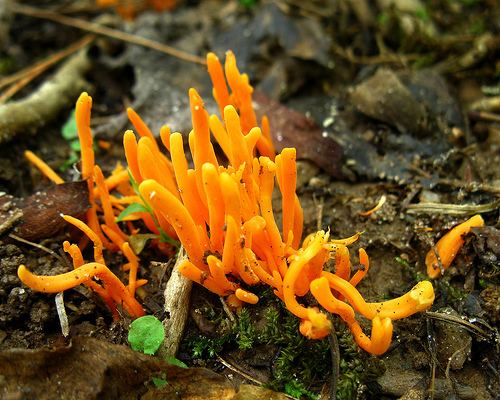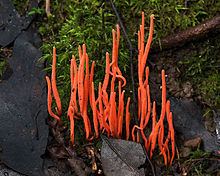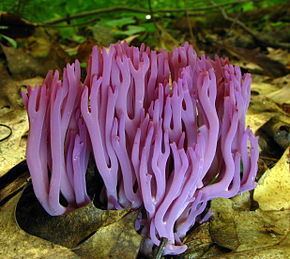Scientific name Clavariaceae Rank Family | Division Basidiomycota Higher classification Agaricales Order Agaricales | |
 | ||
Lower classifications | ||
Coral fungi clavariaceae ramaria on burned log
The Clavariaceae are a family of fungi in the order Agaricales. Collectively, they are commonly known as coral fungi due to their resemblance to aquatic coral, although other vernacular names including antler fungi, finger fungi, worm mold, and spaghetti mushroom are sometimes used for similar reasons.
Contents
- Coral fungi clavariaceae ramaria on burned log
- Coral fungi clavariaceae clavulina rugosa
- Taxonomy
- Description
- Habitat and distribution
- Ecology
- Genera
- References

Coral fungi clavariaceae clavulina rugosa
Taxonomy

Clavariaceae was circumscribed (as "Clavariae") by French botanist François Fulgis Chevallier in 1826. It was one of five families (along with the Agaricaceae, Hydnaceae, Polyporaceae, and Thelephoraceae) that Elias Fries used to divide the Agaricales and Aphyllophorales in his influential work Systema Mycologicum. The family served as a convenient placement for all genera containing species with superficially similar coral-like fruitbodies. It was first Marinus Anton Donk and later E.J.H. Corner who realized that in this broad sense, the family was not a natural phylogenetic assemblage of related species. Corner published his world monograph in 1950 (revised in 1967 and updated in 1970), introducing the modern concepts of many genera of clavarioid fungi. Corner included three genera in his original concept of the Clavariaceae: Clavaria, Clavulinopsis, and Ramariopsis. Molecular phylogenetic analysis has since shown that the Clavariaceae belong to the order Agaricales.

Camarophyllopsis, a gilled mushroom which had previously been placed in the family Hygrophoraceae based on its morphology, was found to belong in the Clavariaceae by Matheny et al. (2008) in a multilocus DNA study. Although traditionally classified in Clavariaceae based on morphology, molecular phylogenetic analysis suggests that Scytinopogon clusters within the genus Trechispora (order Trechisporales).
Molecular genetics has shown that some superficially similar species are not so closely related. The fairy club genus Clavariadelphus, Ramaria and Clavulina belong to the family Gomphaceae, Lentaria belongs in the order Thelephorales, while the genus Calocera is a member of Dacrymycetes, a different class of fungi entirely. The fungus once known as Clavaria purpurea has been moved to its own genus, Alloclavaria in the order Hymenochaetales.
Description
Coral fungi can be similar in appearance to jelly fungi. They are often brightly colored, mostly oranges, yellows, or reds, and usually grow in older mature forests. Hyphodontiella is the sole genus of corticioid (crust-like) fungi in the Clavariaceae.
Habitat and distribution
Some Clavariaceae species have a cosmopolitan distribution, or nearly so. For example, Clavaria fragilis has been recorded on five continents. Other widely distributed species include Ramariopsis pulchella, known from North and South America, and New Zealand, and Clavulinopsis laeticolor, which is also found in Malaysia. In contrast, some groups of species, such as dark-colored Clavulina, are typically found on only a single continent, and may be quite rare.
Ecology
The trophic status of the Clavariaceae has been debated in the scientific literature. It has been variously described as saprotrophic, mycorrhizal, or unknown. Experimental techniques commonly employed to determine trophic strategy, such as stable isotope analysis and phylogenetic analysis of environmental sequences (DNA that is released from an organism into the environment), have not often been used with Clavariaceae species. Birkebak and colleagues suggest that, excluding lignicolous (wood-decaying) species, the Clavariaceae are biotrophic.
Genera
A 2008 estimate placed 7 genera and 120 species in the family; Hirticlavula was added to the family in 2014. In 2013, Birkebak and colleagues suggested that there were 126 operational taxonomic units in the Clavariaceae, about half of which were known from environmental DNA sequences.
